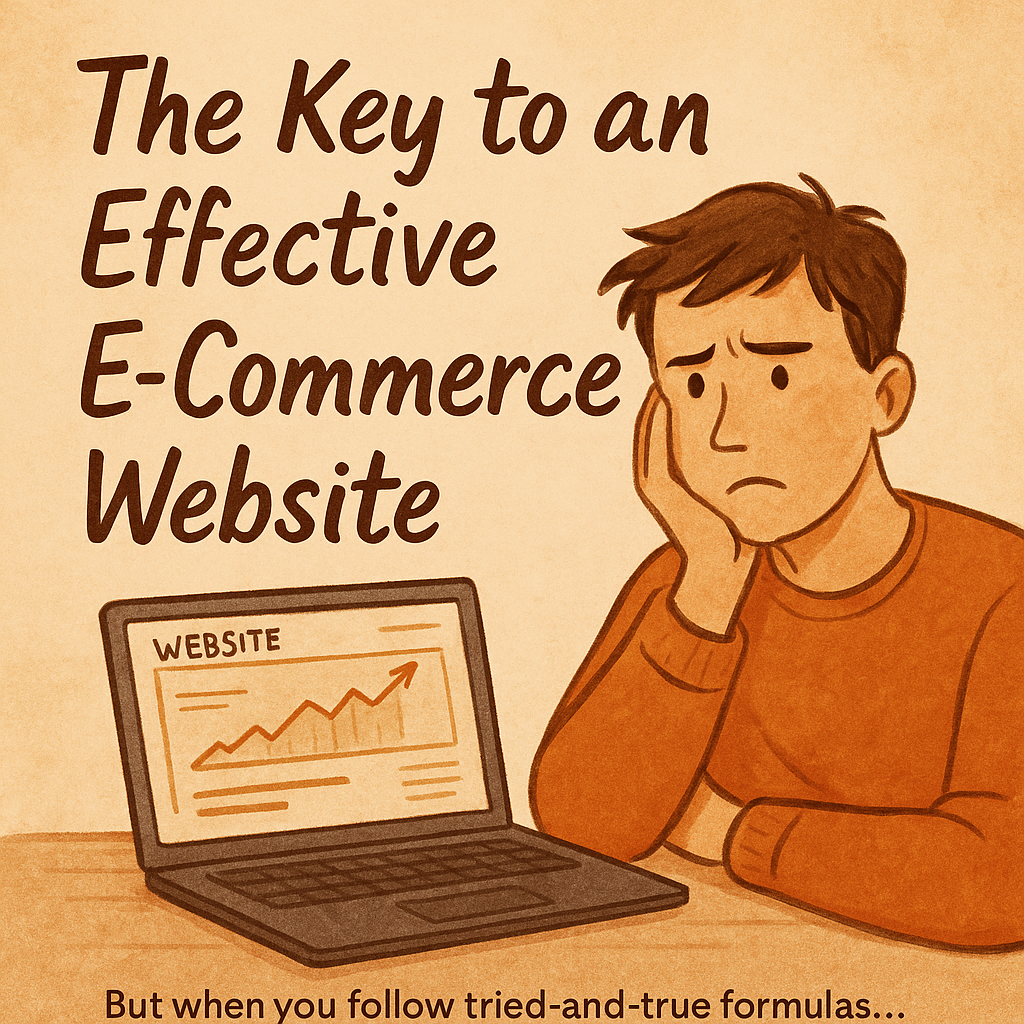What’s the difference between ecommerce entrepreneurs making $10K/month and those making $100K/month? It’s not their products, platforms, or ad budgets. It’s their systematic approach to uncomfortable growth activities.
THE ECOMMERCE REALITY CHECK
Here’s what nobody tells you about building a successful ecommerce business:
Success isn’t about finding the perfect product or viral TikTok ad. It’s about consistently doing the boring, uncomfortable work that compounds over time.
I’ve analyzed 200+ ecommerce businesses that scaled from $0 to $1M+. The pattern is crystal clear:
The 90% who fail: Chase shiny objects, avoid difficult tasks, quit when growth slows
The 10% who succeed: Build systems, embrace discomfort, persist through plateaus
The math is brutal but simple: Ecommerce Success = (Uncomfortable Actions × Consistency) ÷ Time
THE 7-SYSTEM ECOMMERCE TENACITY FRAMEWORK
1. THE REVENUE DIVERSIFICATION PROTOCOL
❌ Don’t: Rely on one traffic source or product
✅ Do: Build systematic revenue redundancy
THE 3-2-1 RULE:
– 3 traffic sources minimum (paid ads, organic, email)
– 2 product categories minimum
– 1 new revenue stream every quarter
UNCOMFORTABLE TRUTH: Your Facebook ads will get shut down. Amazon will change their algorithm. Plan accordingly.
IMPLEMENTATION:
Week 1: Audit current revenue sources
Week 2: Identify biggest single point of failure
Week 3: Launch diversification experiment
Week 4: Set up tracking and measurement
2. THE DATA-DRIVEN DECISION ENGINE
❌ Don’t: Make decisions based on feelings
✅ Do: Build systematic data collection and analysis
THE ECOMMERCE METRICS STACK:
– Customer Acquisition Cost (CAC) by channel
– Lifetime Value (LTV) by cohort
– Return on Ad Spend (ROAS) by campaign
– Inventory turnover by SKU
– Email revenue per subscriber
UNCOMFORTABLE ACTIVITY: Spend 30 minutes daily reviewing numbers instead of scrolling social media
THE WEEKLY DATA RITUAL:
Monday: Review weekend performance
Wednesday: Mid-week optimization check
Friday: Weekly performance analysis and next week planning
3. THE CUSTOMER OBSESSION SYSTEM
❌ Don’t: Assume you know what customers want
✅ Do: Build systematic feedback loops
THE 3-TOUCH CUSTOMER RESEARCH:
1. Pre-purchase: Exit-intent surveys on product pages
2. Post-purchase: Follow-up email sequence with feedback requests
3. Post-delivery: Review requests with specific improvement questions
UNCOMFORTABLE TRUTH: Reading negative reviews and customer complaints is more valuable than celebrating positive ones.
MONTHLY CUSTOMER INTERVIEWS:
– 5 recent customers (why they bought)
– 5 cart abandoners (why they didn’t buy)
– 5 repeat customers (what keeps them coming back)
4. THE INVENTORY INTELLIGENCE FRAMEWORK
❌ Don’t: Guess at inventory needs
✅ Do: Build predictive inventory systems
THE INVENTORY EQUATION:
(Historical Sales × Seasonal Multiplier × Growth Rate) + Safety Stock = Order Quantity
UNCOMFORTABLE DISCIPLINE: Order inventory based on data, not gut feelings about “hot products”
WEEKLY INVENTORY REVIEW:
– Products with <30 days of stock
– Slow-moving inventory (>90 days)
– Seasonal demand forecasting
– Supplier lead time tracking
AUTOMATION TRIGGERS:
– Auto-reorder at 45-day inventory levels
– Discount campaigns for 90+ day inventory
– Supplier performance scorecards
5. THE CONVERSION OPTIMIZATION LABORATORY
❌ Don’t: Set up your store and forget it
✅ Do: Treat every page as an ongoing experiment
THE A/B TEST PIPELINE:
Week 1: Product page headlines
Week 2: Add to cart button colors/copy
Week 3: Checkout flow optimization
Week 4: Email sequence testing
UNCOMFORTABLE COMMITMENT: Test even when things are working well
THE CONVERSION AUDIT CHECKLIST:
– Mobile load speed (<3 seconds)
– Product page conversion rate (>2%)
– Cart abandonment rate (<70%)
– Email open rates (>25%)
– Email click rates (>3%)
RULE: Never run your store without an active A/B test
6. THE SCALING PREPARATION PROTOCOL
❌ Don’t: Scale before systems are ready
✅ Do: Build infrastructure that can handle 10x growth
THE SCALING READINESS CHECKLIST:
– Customer service can handle 10x inquiries
– Inventory systems can track 10x SKUs
– Fulfillment can process 10x orders
– Financial systems can handle 10x revenue
UNCOMFORTABLE INVESTMENT: Spend money on systems before you “need” them
THE TEAM BUILDING SEQUENCE:
1. Virtual Assistant (customer service, basic tasks)
2. Marketing Specialist (ad management, content)
3. Operations Manager (inventory, fulfillment)
4. Data Analyst (metrics, optimization)
DELEGATION RULE: If you can document it in 30 minutes, you can delegate it
7. THE COMPETITIVE INTELLIGENCE MACHINE
❌ Don’t: Ignore your competition
✅ Do: Systematically monitor and learn from competitors
THE WEEKLY COMPETITOR AUDIT:
– New product launches
– Pricing changes
– Marketing campaigns
– Customer reviews analysis
– Social media strategy shifts
UNCOMFORTABLE TRUTH: Your competitors are studying you. Study them back.
THE COMPETITIVE ADVANTAGE FRAMEWORK:
1. Identify what competitors do well
2. Find what they do poorly
3. Innovate where they’re not looking
4. Execute faster than they can respond
TOOLS STACK:
– SEMrush for keyword/ad intelligence
– SimilarWeb for traffic analysis
– Facebook Ad Library for creative research
– Google Alerts for brand mentions
THE ECOMMERCE SUCCESS METRICS DASHBOARD
DAILY TRACKING (5-minute morning ritual):
Revenue (yesterday vs. same day last week)
Conversion rate (store-wide)
Ad spend and ROAS
Email revenue
⚡ Site speed and uptime
WEEKLY DEEP DIVE (30-minute Sunday review):
Traffic sources and quality
Customer acquisition costs by channel
Product performance analysis
Inventory levels and turnover
Customer lifetime value trends
MONTHLY STRATEGIC REVIEW (2-hour session):
Goal achievement vs. targets
Profit margin analysis
Team performance and needs
Growth opportunities and threats
System optimization priorities
⚠️ THE ECOMMERCE FAILURE MODES
MOST COMMON MISTAKES:
1️⃣ Chasing viral products instead of building systems
2️⃣ Scaling ads before optimizing conversion rates
3️⃣ Ignoring customer feedback until it’s too late
4️⃣ Running out of inventory during peak seasons
5️⃣ Building on rented land (single platform dependency)
THE ANTIDOTES:
✅ System-first, product-second approach
✅ Conversion optimization before ad scaling
✅ Weekly customer feedback reviews
✅ Quarterly inventory planning sessions
✅ Multi-platform revenue diversification
THE 90-DAY ECOMMERCE TRANSFORMATION
DAYS 1-30: FOUNDATION BUILDING
Implement data tracking systems
Establish daily/weekly metric reviews
Launch customer feedback collection
Audit and diversify revenue sources
DAYS 31-60: OPTIMIZATION PHASE
Run first A/B tests on key pages
Optimize inventory management systems
Hire first virtual team member
Scale winning marketing channels
DAYS 61-90: ACCELERATION MODE
Launch new product/market experiments
Automate repetitive processes
Implement advanced analytics
Plan next quarter’s growth initiatives
THE UNCOMFORTABLE ECOMMERCE TRUTHS
Truth #1: Your first product probably won’t make you rich. Your systems will.
Truth #2: Successful ecommerce is 80% boring operational work, 20% exciting creative work.
Truth #3: The businesses that survive algorithm changes are the ones that don’t depend on algorithms.
Truth #4: Your competition isn’t other stores. It’s Amazon, and they’re getting better every day.
Truth #5: Customer acquisition is getting more expensive. Customer retention is getting more valuable.
THE 24-HOUR CHALLENGE
Most ecommerce entrepreneurs will read this, feel motivated, then do nothing. The 1% who actually implement these systems have one thing in common: They start before they feel ready.
Your 24-hour implementation challenge:
Pick ONE system from the framework above
Set a 25-minute timer (Pomodoro technique)
Take the first implementation step right now
Schedule the next step in your calendar
Tell someone what you’re committing to
Remember: Your competitors are reading the same growth articles. The difference is what you do in the next 24 hours.
THE BOTTOM LINE
Building a successful ecommerce business isn’t about finding secrets or hacks. It’s about systematically doing the uncomfortable work that others avoid:
Analyzing data when you’d rather create content
Talking to unhappy customers when you’d rather celebrate wins
Building systems when you’d rather chase new opportunities
Investing in infrastructure when you’d rather boost ad spend
The question isn’t whether these systems work. The question is: Are you willing to do what your successful competitors are already doing?
Start with one system. Start today. Start before your next product launch, before your next ad campaign, before you feel “ready.”
Because in ecommerce, the best time to build systems was at your first sale. The second best time is right now.
IMMEDIATE ACTION ITEM: Open your analytics dashboard right now. Spend 5 minutes identifying your biggest single point of failure. Then pick the system above that addresses it. Set a timer for 15 minutes and take the first step. Do it before you read another article or check another notification.
Your future 7-figure self is counting on what you do in the next 15 minutes.




